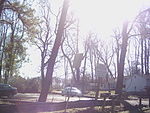Chickahominy River

The Chickahominy is an 87-mile-long (140 km) river in eastern Virginia. The river, which serves as the eastern border of Charles City County, rises about 15 miles (24 km) northwest of Richmond and flows southeast and south to the James River. The river was named after the Chickahominy Indian tribe who lived near the river when the English colonists arrived in 1607. Chickahominy descendants live in Charles City County today. During the American Civil War (1861–65), the upper reaches of the river became a major obstacle to Union General George B. McClellan's Peninsula Campaign, a failed attempt in 1862 to capture the Confederate capital of Richmond. Docile, narrow, and relatively easily crossed during dry weather, after periods of rain, the river expands across a flood plain with swamps as much as a mile across. The Chickahominy was in flood stage and divided the Union Army during crucial periods, despite continuous efforts by the United States Army Corps of Engineers to build and maintain bridges. Other battles were fought nearby in 1864. Part of a popular recreational area for boating, waterskiing, and sport fishing, featuring Walkers Dam and Chickahominy Lake, the lower Chickahominy River has become a major source of drinking water for the lower portion of the Virginia Peninsula in modern times. It also serves as a border for the Chickahominy Wildlife Management Area.
Excerpt from the Wikipedia article Chickahominy River (License: CC BY-SA 3.0, Authors, Images).Chickahominy River
Geographical coordinates (GPS) Address Nearby Places Show on map
Geographical coordinates (GPS)
| Latitude | Longitude |
|---|---|
| N 37.233611111111 ° | E -76.889722222222 ° |
Address
Charles City County
Virginia, United States
Open on Google Maps






